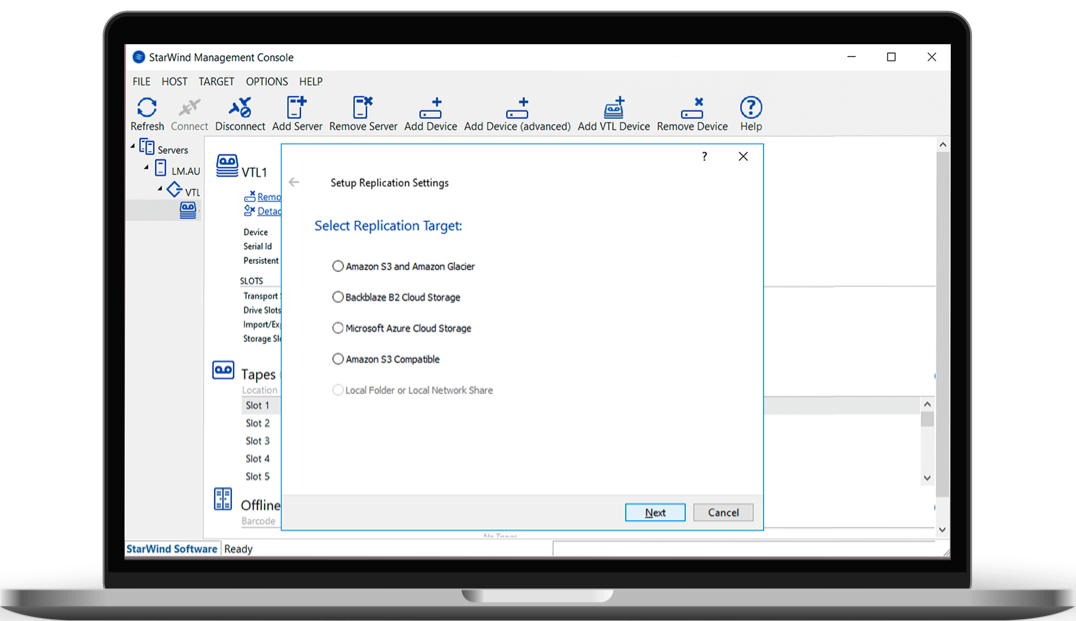Virtual tape libraries, and cold-but-warm storage with StarWind VTL
Good backup practice too often comes about as the direct result of a disaster. That’s an unfortunate truth known by IT professionals who, throughout their careers, have often had to deal with highly stressed end-users. The loss of priceless and unique files, archives, bodies of work, and in some cases, intellectual property causes every type of reaction from angst to tears – and almost always, regret.
Just a decade ago, safe and secure backups usually meant taking physical media offsite, and that’s a prevalent practice today, although it’s been renamed as the charming “sneakerware.” Taking offsite backups has become much easier than arranging a daily tape backup picked up by courier, but it’s not a great deal cheaper in many cases. An offsite backup today usually means cloud storage, and disk space from the go-to providers does not come cheap.
But deploying good practice in the form of 3-2-1 (three copies of all data, two onsite on different media, one offsite) need not necessarily mean huge costs or turning to small cloud storage providers that may not be in business a year from now. Today’s virtualization technologies offer companies of any size, including those with limited means, the ability to archive to virtualized tape – that is, de-duped and compressed for maximum storage efficiency but remaining in the digital realm.
Virtual tape libraries offer the logical middle ground between “hot” copies held on fast flash drives and “cold” archives kept offsite on spinning rust, DLT, or other slow but reliable media. VTLs (virtual tape libraries) are perfect for companies refreshing their IT provision, be that a wholesale move to the cloud or establishing a hybrid solution for storage that leverages the best of both worlds.

Source: StarWind Software
As well as the relative speed of restoring lost data, the cost of storage infrastructure maintenance can point the budget-aware systems administrator toward VTL technologies. This was the exact situation at Neuron Computer Services, which needed to overhaul its legacy on-premise drive-based storage to gain the OPEX-based finance, and technological advantages the cloud offers.
The company’s IT administrators wanted to continue with the Veeam-based backups of live data for a fast recovery posture but make better use of Neuron’s investment in cloud storage at Backblaze. The StarWind VTL offered just such a bridge, enabled by the platform’s compatibility with both Veeam and Backblaze B2. Backblaze storage is low-cost yet highly reliable and trusted throughout the IT industry, so the StarWind VTL platform allowed Neuron Computer Services to backup to its existing highly-secure cloud instance without breaking the bank. Staff no longer had to manually copy data onto drives, load those drives into Pelican cases and lug the cases offsite. The StarWind VTL creates efficient, immutable archives that can be decompressed and brought back online and made accessible in minutes.
At a time when ransomware can migrate across LANs, sectioning the network physically as well as in VLANs at network level is excellent practice, but it can be technically challenging for many organizations. Simpler but more expensive backup and failover options may not, therefore, be attractive to money-conscious smaller businesses that have to prioritize IT spending. VTL technology offers a highly attractive alternative.
Daifuku Northern Holding Company had begun a virtualization journey to help with data replication and backups and was relying on disk backups assigned to VMs running Hyper V. But despite the abstraction of OSes in the hypervisor that kept sysadmin costs low, physical backups were still costly to administer and maintain. The company deployed the virtualized tape library from StarWind and achieved the 3-2-1 model: now, it backs up to VM-mounted disk and writes a copy to physical tape onsite (thus realizing two copies of data on different media). For the final element (the “1” in 3-2-1), the StarWind VTL automatically creates a virtual tape copy in the cloud, thus keeping critical data air-gapped.
Daifuku keeps its operations safer and has an impressively short MTR (mean time of recovery) from “cold” archives held in the cloud. In the unpleasant event of a cybersecurity attack resulting in encrypted local clients, data could be restored quickly, minimizing downtime and reducing the risk of large-scale data loss. Paying ransom to ransomware hackers will never have to be considered.
Even among seasoned IT professionals, backups, disaster recovery, and restore time metrics are a far-from-glamorous area of operations, but one that comes into its own when (not if) problems occur. Keeping the business on course with highly reliable yet low-cost archiving needs a convergent and virtualized solution. The StarWind VTL wins our nod of approval: it’s enterprise-grade storage virtualization at price points that make financial sense. In combination with the company’s well-regarded support infrastructure and the option of a fully-managed service, StarWind’s solutions in this space remain among the very best options.
Find out more about StarWind and its range of virtual storage solutions by following this link.









